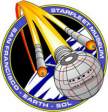 |
 |
Giant-Class Transports
![]() Diagrams
Diagrams![]()
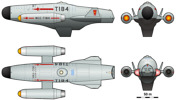 Giant class |
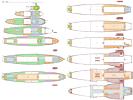 Giant cargo plans, part 1 created by Allen Rolfes (see notes) |
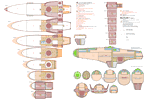 Giant cargo plans, part 2 created by Allen Rolfes (see notes) |
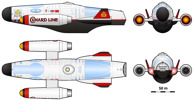 Giant civilian version |
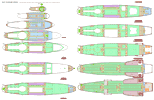 Giant passenger plans, part 1 created by Allen Rolfes (see notes) |
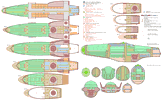 Giant passenger plans, part 2 created by Allen Rolfes (see notes) |
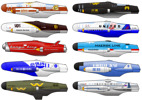 Giant civilian liveries |
![]() History
History![]()
Giant transports were the first high-speed, long-range, high-capacity transport ships to enter service with Starfleet and civilian services. The class heralded a new era of interstellar transportation and commerce in the Federation, establishing stronger political and economic bonds between the far-flung member worlds.
The Age of Imperialism
At the dawn of the 23rd century, the human-dominated United Federation of
Planets (UFP) was expanding through the Alpha and Beta Quadrants of the galaxy
at an rate of nearly 1000 cubic light-years (ly) per year. Human colonization
policy before the Earth-Romulan War was, for the most part, continued by the UFP
in the decades after the war. This policy called for incentivized emigration
from heavily populated core worlds to newly colonized M-class planets able to
sustain large populations through native agriculture and resources. However,
incentives were rarely needed to encourage emigration. After its victory over
the Romulans, the human race was imbued with energy, confidence, and a
near-messianic conviction that it was destined to spread throughout the galaxy.
Thanks to the advanced technologies of the late 22nd century, life in the core
human systems of the UFP had become prosperous, safe, and, according to many
inhabitants, extremely boring. The recent war against the Romulans had given
humans a taste for excitement and adventure that could now be satisfied only by
leaving Earth and taming alien worlds.
This desire for interstellar colonization was so great that an estimated 5% of the inhabitants of the Sol and Centauri systems applied to emigrate in the 4 decades after the war. Despite the great distances involved, the number of would-be colonists overwhelmed the ability of the Federation Colonization Commission (ColCom) to find new worlds for them all. Such was the popularity of emigration that as soon as a new star system was surveyed, colonists would attempt to establish homesteads, often without sanction, even on worlds that were only marginally capable of sustaining human life or whose ownership was in dispute. The eager colonists were no longer willing to wait decades for terraforming, which might have made their new homes more hospitable. In many cases, colony ships were sent to systems that had not even been reached by survey ships, so that claims could be made on prime planetary real estate and resources.
Of course, not everyone in the UFP was comfortable with this rapid expansion. Many citizens felt that the humans, who comprised 63% of the young UFP's population, were a technologically advanced yet dangerous, undisciplined, and ethically stunted race that was determined to expand despite the inevitability of conflict with the Federation's neighbors and would recklessly drag it into war. The human race, they felt, was destined to eventually destroy itself, and the Federation with it. Other opponents of expansion feared that recurring cycles of expansion, discord, and conflict would turn the UFP into a heavily armed imperialist power completely at odds with its founding principles of peace and cooperation. Although Skon, Vulcan’s long-time ambassador to the Federation, had spent much of the last quarter century attempting to curtail what he saw as the growing militarization of Starfleet (See the Paris-class article for further details), by the turn of the 23rd century, he was forced to admit that the present Federation expansionist policies had broad support among the growing population of the Homeworld Core of the Federation and that the juggernaut of colonization was unlikely to be stopped.
Strings of Pearls
The slow, short-range fusion-powered transport ships available before the
Earth-Romulan War and the first decade afterward required a pattern of
colonization in which the most recently settled star system served as a jumping
off point for colonizing the next most distant star system, usually within 3
parsecs (9.75 ly). Once settled and home, after a decade or more, to a growing
indigenous population and a well-developed industrial and agricultural base, the
young world would be able to generate or support the colonization effort to the
next star system. In such a way, colonies would slowly spread out from the core
worlds of the UFP like long strings of widely spaced pearls. (See star chart,
Federation Core Systems, 2170)
As new worlds were colonized and colony strands lengthened, the distances from Earth, and from other colony strands, became greater. For example, the mining planet Ogun (NN 3412) was the eighth colony in a strand starting at the core system of Zhoudingyi (Beta Comae Berenices). Because commercial starship lines operated only short routes between nearby star systems, to travel to Earth a resident of Ogun would have to make a trip of nearly 30 parsecs in 9 or more legs, although Ogun is only 10 parsecs from Earth. Even with the introduction of civilian matter/antimatter (M/AM) reactors, to complete such a 30-parsec trip to Earth the fastest postwar Bison transport at its maximum cruising speed of wf 3.3 would take at least 3 years, not counting the waiting time at each star system. Similarly, emigrants from core worlds would need to travel for 3 years just to reach the outermost bridgehead for new colonies. This long transit time and the time needed for a bridgehead colony to develop to a point where it could independently launch a colonization effort were much greater than the human population of the core worlds was willing to tolerate. Clearly, this paradigm of colonization could not support emigration at the volumes and speeds humanity desired.
The great distances between the UFP core and outlying colony worlds also limited the transport of people, foodstuffs, raw materials, and manufactured goods. Although the "string of pearls" colonization pattern facilitated the economic development of mutually supporting chains or clusters of colony worlds in nearby star systems, the distances of colony strands from Earth and from other colony strands tended to increase quickly. As a result, each strand became more isolated from Earth and from other strands. There were fears that these great distances would eventually weaken the political and cultural links between these outlying colony worlds and the Federation core, damaging the cohesion of the Federation and leading to its eventual breakup.
Nonhuman species that had recently joined the UFP were also affected by their great distances from the Federation core. The UFP had touted membership as being mutually beneficial: the new member would gain protection, brotherhood with dozens of species, and access to markets and advanced technology, while the Federation would benefit from Starfleet basing rights, free passage across the member's space, and the addition of a distinctive new culture to the diversity of the Federation. However, because of the great distances to the UFP core, many new members felt they had benefited little from UFP membership. With the infrequent visits by minor Starfleet vessels and low-level commissioners, the founding powers of the UFP, especially the humans, often seemed more like absentee landlords than galactic peers. Many new members felt that they had surrendered a measure of their sovereignty to become yet another steppingstone in the march of humanity across space.
As UFP colonization efforts penetrated deeper into previously unexplored space, the risks of resistance from other powers or attack from hostile species became more acute. Exacerbating these risks was the human habit of colonizing star systems whose ownership was disputed. Protecting these colonies and other UFP areas required constant vigilance and the armed might of Starfleet. However, Starfleet did not have enough ships and starbases to guard against all possible threats in all possible locations. Starfleet was doing its best, but lacked the ability to rapidly establish starbases in frontier areas or to rapidly redeploy its limited number of cruisers among all areas in need of protection.
A New Transport System for the Federation
By the end of the 22nd century, it was becoming clear to UFP planners that its
system of interstellar transportation, in which stars were linked to one another
in a haphazard manner with journeys of the shortest possible length, was too
slow and disorganized to support the desired levels of colonization, commerce,
defense, and diplomacy. To replace this system, the Federation sought to develop
a new system in which the major stellar systems of the Federation core and of
outlying areas would be linked by long, direct routes and serve as bases for
shorter journeys to surrounding stars. Such a "hub and spoke" system would
tie the Federation together in numerous ways. However, to establish and operate
such a Federation-spanning transportation system, Starfleet and commercial lines
lacked both the necessary infrastructure and the transport ships possessing the
combination of high speed, long range, and large capacity.
A capability long coveted by Starfleet and ColCom was what was known as "Starbase in a Box" or "Colony in a Can." This capability would allow the equipment and personnel needed to construct and operate a starbase or to establish and populate a colony to be quickly transported in a single journey. Lacking this capability, Starfleet and ColCom were forced to make multiple trips with small, fast ships or single trips with large, slow ships. Starfleet's previous class of large transports, the Ocean class of 2168, which had been built to replace the large, slow prewar Bison-class transports, could certainly carry large payloads, but Starfleet's Transport Command had specified, with an astounding lack of foresight, a cruising speed of only wf 3.2 (33 c), believing that higher speeds would wrongly signal an aggressive or expansionist intent. However, by 2175, civilian transport ships regularly reached speeds of 75 c or more (wf 4.2). Accordingly, within a decade of entering service, the Oceans were considered unbearably slow. By the start of the 23rd century, Starfleet had lost any fear of "sending the wrong message" and actively sought a large, fast, long-range transport ship that could support the Federation's expansionist policies.
In an attempt to compensate for the slow Ocean class, in the 2180s Starfleet had obtained the 50-ship Constellation class, a military version of the fast civilian Sozvezdie transport, which had introduced high-speed, long-range M/AM-powered civilian transport to the UFP. Although Sozvezdie had a cruising speed of wf 4.4 (85 c), this speed had come at the expense of payload. Sozvezdie transports had been designed to be smaller than slower ships of its time, to ensure high occupancy and payload rates and, therefore, to maximize profitability for civilian operators. By the end of the 22nd century, however, demand was growing for cargo and passenger ships that combined the high speed of Sozvezdie with the large payloads of the Bison and Ocean classes. Attempts to lengthen Sozvezdie and increase payloads had been disappointing, as its narrow beam did not provide sufficient longitudinal rigidity without the introduction of heavy strength members that further decreased cross-sectional areas and payloads. Several Sozvezdies were fitted with "speed pallets" on the top, bottom, or sides of the hull to carry additional cargo but not, for safety reasons, additional passengers. These measures yielded only modest increases in payload and were, at best, temporary.
In April 2204, the Federation Transportation Commission (TransCom) announced the Century 23 Spacelanes Initiative (SI-23) to establish a UFP-spanning hub-and-spoke transport network with the goal of promoting and facilitating colonization, commerce, defense, and "galactic amity." More than 3 decades earlier, in 2170, the UFP had announced the first Spacelanes Initiative with many of the same goals, but ships capable of supporting such an ambitious transport network were not available. This time, however, TransCom had the technology, the financial resources, and the support of Starfleet, ColCom, and the Federation Commerce Commission (ComCom) to establish a true Federation-spanning transport network. SI-23 called for the selection and development of regional transport hubs where the Federation would subsidize the construction or upgrade of Starfleet starbases; freight handling and passenger terminals; orbit-to-surface matter transporters; facilities for traffic control, the production, storage, and refueling of M/AM, and the repair and maintenance of starships; long-range subspace transmitters; and offices and accommodations for Federation bureaucrats. The chosen systems would become the de facto "capitals" of their sectors of space and could be predicted to undergo explosive growth once the project had been completed.
The various UFP commissions involved in choosing star systems as regional transportation hubs were expected to weigh numerous factors. These factors were likely to include population, cultural development, scientific and educational institutions, agriculture, raw materials, numbers of class-M planets, facilities for cargo and passengers, intrasystem and intersystem starship traffic, starship lines serving the system, and proximity to surrounding star systems. Political considerations were also likely to be important, as a stated goal of SI-23 was to strengthen the bonds between newer Federation members (and even potential members) to the more established members of the Federation. However, which factors were considered most important by Starfleet, ComCom, ColCom, and TransCom was a closely held secret, which meant that much effort was expended by candidates systems to determine the exact calculus by which the final decisions were to be made so that they could be predicted and, possibly, influenced.
SI-23 promised to be the costliest infrastructure project since the founding of the Federation and, for selected star systems and construction companies, the most lucrative. Such was the expected economic windfalls that none of the candidate star systems, human or nonhuman, dared leave the selection process to luck or mere merit. Every interested party sent an army of bureaucrats, politicians, and lobbyists to Earth by the fastest ships at their disposal so that they could exert as much influence and pressure as possible for as long as possible on the decision-makers before the winners were to be announced in 2 years’ time. Together with the Lancaster heavy cruiser project of 2201, SI-23 was marked by levels of corruption and malfeasance unprecedented and unsurpassed in Federation history. However, regardless of the numerous instances of misconduct surrounding the selection of transport hubs, the star systems finally chosen as hubs were, with a few notable exceptions, the most deserving candidates.
Starfleet's Giant Class
In May 2204, Starfleet's Ship Specifications Review Board announced the
developmental pathway for a new 100-ship class of large transports for
Starfleet, to be called the Giant class. The target specifications for
the Starfleet's Giant class called for a ship able to carry 400
passengers and a payload of 7800 standard cargo containers or 100,000 cubic
meters a distance of 37 ly at a cruising speed of at least wf 4.5. The basic
hull and drive elements were to be designed at Starfleet's Utopia Planitia
Yards at Mars. The spaceframes were then to be constructed and assembled there
and at other Starfleet yards throughout the UFP. Of the spaceframes assembled
during the first 5 years (from 2206 through 2210), 100 were reserved for
Starfleet's Giant class, and a further 20 for ColCom's Colonial
Transportation Service. However, other spaceframes produced during that time and
thereafter could be purchased at cost by civilian ship builders, who would
outfit them as passenger liners and cargo ships and sell them to civilian
transportation companies. By having Starfleet transports and civilian liners and
cargo ships all based on the same propulsion system and hull, the Starship
Specifications Review Board and the various Federation commissions hoped that
the costs of design, production, operation, and maintenance would be decreased
for Starfleet and for the entire Federation civilian transport system.
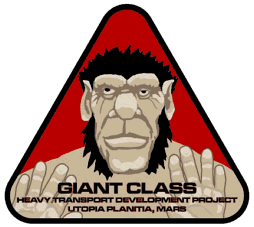
To encourage ship builders to develop and construct civilian versions of Giant and then to encourage commercial freight and passenger lines to purchase these ships and put them in service, TransCom would provide, through the Federation Central Bank, long-term, low-interest loans. Such loans were considered necessary because servicing the initial purchase of a starship, especially extremely expensive passenger liners, normally comprises the largest part of the yearly operating costs of a starship and is the greatest obstacle to profitability of a commercial passenger or cargo fleet.
When the Giant project was announced several manufacturers of large transports and passenger liners complained that Starfleet was willfully destroying the UFP's ship-building industry by supplying low-cost hulls and drive systems to the civilian market. However, TransCom countered that the ultrahigh-speed, ultralong-range, ultrahigh-capacity segment of the market had so far been completely ignored by current ship builders and designers. TransCom maintained that they were creating an entirely new sector of transportation that would funnel high volumes of passengers and cargo into designated hub star systems and would spur the construction and purchase of ships to shuttle cargo and passengers between the hubs and neighboring stars.
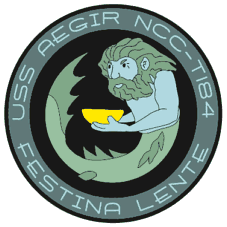
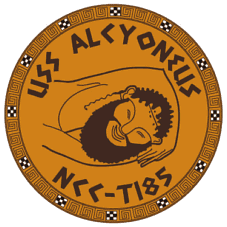
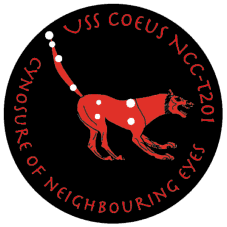
The first unit of Starfleet's Giant class (USS Aegir, NCC-T184) joined Transport Command in 2207 (and was followed by the rest of the 100-ship class over the following 4 years). Although the wait had been long, Starfleet finally received the large, fast long-range transport it had wanted since the 2170s. By displacement, Giants (418,000 t) were not as large as the largest prewar Bisons (495,000 t) but had a much larger usable payload because it no longer needed to carry large volumes of deuterium for a fusion reactor to power the warp drive. However, Giant’s displacement was 33% greater than that of Ocean (315,000 t) and 132% greater than that of Constellation (180,000 t). The warp drive of Giant was powered by a military-grade SSWR-III-J M/AM reactor near the keel just forward of the fantail. The plasma conduits were routed forward through the hull to emerge behind the large main cargo bay and attach through supports to the rear half of the immense forward-positioned Jumbo nacelles. The warp drive system could attain a cruising speed of wf 4.6 (97 c) for 38.5 ly and a maximum speed of wf 5.3 (149 c). Forty-eight standard AM bottles for onboard use were housed in a bunker directly below the M/AM reactor, and an additional 277 AM bottles for auxiliary use and for transport to shore facilities and other ships were housed in a containment canister protruding from the keel of the ship. Sublight propulsion was provided by a pair of twin fusion reactors and impulse thrust assemblies housed in streamlined cowlings on the rear quarter of the hull. Atop the cowlings were large cooling fins for dissipating heat from the fusion and warp reactors; these fins were also a convenient spot for displaying shipping line house flags and other identifying markings.


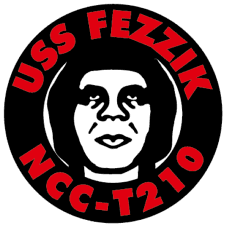
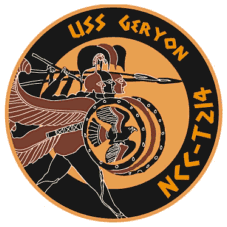

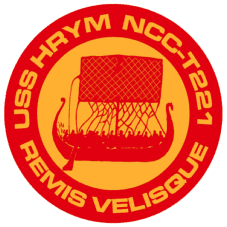
The cargo storage and handling facilities of Giant were the largest on a starship to date. The 72,600-m3 bulk cargo bay and the 28,200-m3 bin cargo bay were located in the lower forward part of the ship, and a container cargo bay for 7,989 standard containers stretch from behind the bulk bay to the mid-part of the ship. Giant's 5 shuttlebays (forward, middle upper and lower, and rear upper and lower bays) were used for loading and off-loading cargo from shuttlecraft and could also be used to carry miscellaneous cargo or several dozen ship-borne fighters, such as Penguins and Puffins, and other small craft. The cargo spaces and shuttlebays were connected by means of a network of corridors and turbolift shafts, although very large cargo items could not be moved between all cargo spaces. Giant's 4 largest cargo transporters could each transport 90-m3 jumbo cargo containers from the container cargo hold to bulk cargo holds or to shuttlebays. The transporters could also be used to transfer cargo to planetary surfaces or to other ships and space stations. However, man-rated transporters were not installed in Giants until after 2215.
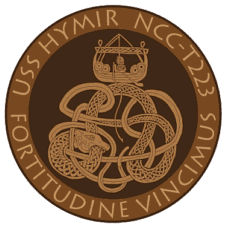

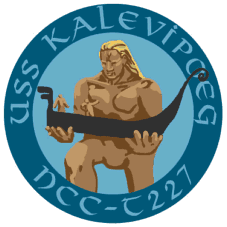
From 2206 through 2210, 120 Giants and Giant-based vessels were constructed for Starfleet and ColCom. The new Giants of Starfleet's Transport Command were quickly enlisted to support the expansion of the Federation's frontiers. With its large cargo and passenger capacities, a single Giant could deliver all the equipment and personnel needed to construct a terrestrial or orbital starbase and operate it for 5 years without resupply. The equipment included prefabricated structures of various types, construction vehicles, M/AM and fusion generators, subspace radio receivers and transmitters, shield generators, matter compilers, protein mills, water purifiers, livestock, agricultural supplies, logic systems, defensive beam and missile batteries, personal weaponry and armor, ground vehicles, shuttlecraft, satellites, transporters, starship maintenance equipment, liquid and gaseous chemicals, medical supplies, and much more. Also delivered were the 400 crew and family members to construct and man the starbase. This capability of rapidly constructing starbases allowed Starfleet and the Federation to quickly establish control over vast areas of space. By 2220, the annual rate of Federation expansion had increased to 1750 cubic ly. (See star chart, Federation Core Systems, 2215)
Once those bases had been established, Giants were used to bring Federation officials and Starfleet crewmen, stores, and supplies from Earth and other core worlds on direct, ultralong-distance routes, rather than being slowly brought up through old colonial strings of pearls. The Giant’s cargo and passengers would then be offloaded in-system or be transloaded to one of Starfleet's slower or less capacious ships, such as Oceans, Constellations, or various courier vessels, and then be distributed to neighboring star systems. The Giant would then return coreward or proceed on another ultralong-distance journey to its next scheduled stop.
However, the rapid expansion of the Federation territory in the decades after the Earth-Romulan War had come at a price. Because the ownership of colony worlds was often disputed by other powers, Federation territorial claims often had to be vigorously defended by Starfleet. As a result, Federation expansion since the start of the 23rd century had been accompanied by an aggressive Starfleet posture and a rapid build-up of forces, as represented by the powerful new Lancaster and Paris classes. Even with these changes, the Federation's defenses were beginning to become overstretched and would eventually require a re-evaluation of Starfleet policies.
Starship Tenders
In addition to serving Starfleet as passenger transports and cargo ships, Giant-derived
vessels served as starship tenders or, perhaps more accurately, task-force
support ships. These ships were an important part of Starfleet's ability to
project power far from the Federation core and to undertake both defensive and
offensive operations without the direct support of starbases. Tenders had large
crews, numerous maintenance craft (work bees), and extensive facilities for
repairing starships large and small, their embarked craft, and their various
onboard components. They had the internal capacity to carry all that was needed
to rearm, refuel, resupply, and replenish starships so that they could continue
operations without having to retire to starbases that might have been many
parsecs to the rear. Giants could also be outfitted with medical
facilities and staff able to care for 100 inpatient casualties per week. The
passenger cabins could be used as temporary berths for starship crews as their
ships were being repaired. Giants were fast enough to keep pace with task
forces and, because they carried no defensive weaponry, to retreat to safety
when threatened.
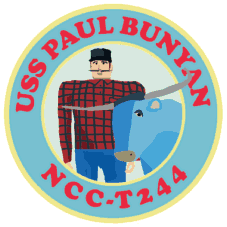
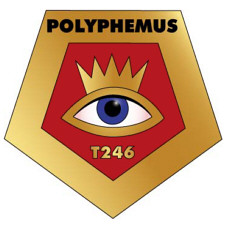
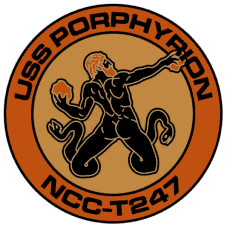
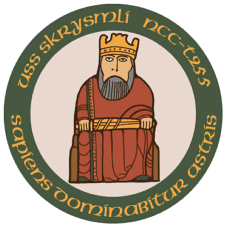
A representative tender mission was the support given by USS Hymir (NCC-T223) to a 6-ship task force led by the Lancaster-class heavy cruiser USS Arronax (NCC-1250) and including 2 Paris-class light cruisers, USS Teheran (NCC-908) and USS São Paulo (NCC-901), and 2 upgraded Hyperion-class survey cruisers, USS Rhea (NCC-858) and USS Tethys (NCC-861). In May 2212 the task force was sent to a system designated Kappa 221 (BD+07˚3967), some 10 pc beyond the Federation border from Ennigaldi (Gliese 726), then one of the Federation's most distant colony systems, to investigate the loss of the long-range explorers SS Magellan and SS Infinity 3 years earlier. Subspace signals and radio messages analyzed by Starfleet suggested that both ships had been pursued, attacked, and destroyed by vessels of a previously unknown race. The Kappa 221 system and several nearby systems had been identified as promising targets for colonization and mineral exploitation.
After a voyage of nearly 3 months, the task force arrived at Kappa 221 in August 2212. A survey of the planets revealed several with fluorine atmospheres, apparently engineered, that showed signs of earlier settlements but were now abandoned. However, no traces of Magellan or Infinity were found. Three weeks later, the task force was confronted by 4 ships of a previously unknown configuration. Arronax transmitted messages of greeting and friendship, which were met with no response. The aliens suddenly charged the task force firing disruptor-like weapons. In the resulting action, all 4 alien ships were destroyed, and Teheran sustained 12 casualties and moderate damage.
Long-range scans of warp signatures by Rhea and Tethys showed that the alien ships had likely originated from the system designated Kappa 223 (BD+07˚3992), some 1.8 parsecs (5.85 ly) away. As Arronax consulted with Starfleet Command, repair crews from Hymir attended to the damaged Teheran. Teheran's port warp nacelle was replaced with a spare carried by Hymir, and her injured crew members were transferred to Hymir's well-equipped sickbay. The missile batteries of the all ships were restocked, and their deuterium stores were topped off from Hymir's internal tanks. The task force was ordered to proceed to Kappa 223.

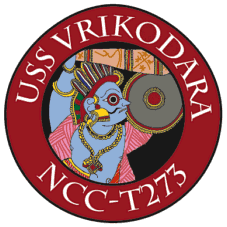
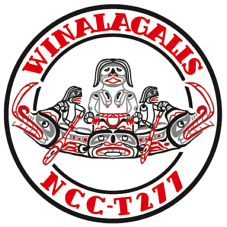
En route to Kappa 223, the task force was attacked by alien ships 3 times without warning. After each action, the task force dropped out of warp for repair and replenishment by Hymir. After a journey of 5 weeks, the task force dropped out of warp near Kappa 223 and was confronted by a fleet of 15 heavily armed ships of various sizes. Sensor scans showed that the star system included 3 terrestrial planets with fluorine atmospheres, all heavily populated. The task force commander, Commodore Alberta Keller of Arronax, realized that the aliens saw the task force's presence in their system as an existential threat and were prepared to do whatever was necessary to repel this "invasion." With this realization, Starfleet ordered the task force to withdraw from the Kappa 223 system. The following day an unarmed shuttlecraft carrying Commodore Keller, her first officer, and Federation Special Ambassador Somak approached the most heavily populated planet to open negotiations. Their overture was accepted, and in 2228 the Zaranites, who were the inhabitants of Kappa 223 and several nearby systems, became members of the Federation. Thanks to the support of Hymir, the task force was able to sustain combat and diplomatic operations far from the Federation core for nearly 9 months.
Civilian Giants
In the first 10 years of Giant hull production (2206 through 2215), some
80 civilian passenger liners and transports were constructed and outfitted. At
first, hulls were produced only by Starfleet yards and then guided by tugs to be
outfitted at civilian facilities. However, because of the inability of the
numerous Starfleet yards to meet the demands of both military and civilian users
for the popular Giant-based hulls, they were later constructed under
license by several civilian shipbuilders.
A famous class of civilian ships based on the Giant hull were the Imperator starliners designed and outfitted for the Cunard Line by Chantiers de la Terre (CDT) at its Saint- Nazaire orbital facilities at Earth. Imperators were intended to be most luxurious, most prestigious ships serving the highest end of the interhub civilian passenger market, befitting the Cunard Line, a company that could trace its roots back 350 years to a steamship operator on the oceans of old Earth. The Cunard Line, however, had not operated continuously for those many centuries; like many companies on Earth, it had gone into eclipse during the dark age following the Third World War. In 2149, the rights to the Cunard name were purchased by the Geumseong chaebol (family-based conglomerate), based in the Astraea system (HN Librae), for a passenger and freight line serving the Libra colonies (the others being Themiste [HO Librae], Mohannak [Gl 570B], and Maat [Wolf 1061]). These worlds, which had been established as agricultural/mining colonies in the early 2120s, had enjoyed explosive growth during and after the Earth-Romulan War and now rivaled Sol and Alpha Centauri as centers for manufacturing, culture, and education. In the post-War boom years, the Cunard Line had expanded to offer service to other systems in the upper Federation core, including Mohannak (Gl 570B), Italpas (Gl 588), Novaya Rossiya (Gleise 526), Zhoudingyi (Beta Coma Berenices), and several Andorian worlds. Now, in the early 23rd century, the Cunard Line sought to transform itself from a regional carrier to a Federation-wide passenger and freight fleet. However, to reach the central and lower regions of the Federation core from its base in the Libra colonies, Cunard ships had to travel at achingly slow speeds or to stop for refueling at the crowded transport hub in the Gateway system (Ross 128), which was dominated by the Red Griffon (Hóng Shī Jiù) clan, the long-time bitter rival of Geumseong. The 5.4-parsec direct journey from Nova Rossiya to Earth while bypassing Gateway would require faster, longer-range ships than the Kuribayashi Commander-class transports that Cunard had been using.
After considering several shipbuilders, Cunard entered into negotiations with the Bel Geddes Astral Corporation to commission a longer-range "stretch" version of its already severely thin Streamliner-class freightliner. These 300-m-long, 30-m-wide greyhounds attracted a high-end clientele for high-speed, short-distance, high-profit routes, such as the Earth-Centauri run. Indeed, in 2202, SS Lakme captured the Blue Riband for Ajira Spaceways with a time shattering the previous record by nearly a full day. However, Streamliner-class ships were expensive to operate and required high fares and high occupancy rates to turn even modest profits. With a longer, wider-beam version of Streamliner Cunard sought a ship able to maintain similar high cruising speeds yet have a longer range. Cunard was confident that the "stretch" Streamliner would pioneer new long-range routes and would be more profitable, should passenger demand for such routes increase as projected. The new Streamliners would certainly have been impressive ships. However, just as the contracts were about to be signed in late 2203, Cunard began hearing rumors from its contacts in TransCom of the soon-to-be-announced Giant project and put its plans on hold.
After Giant and SI-23 were announced, Cunard invited submissions from starship builders to create a Giant-based passenger liner meeting its needs. CDT, which had built and converted luxury liners for major shipping lines since the late 21st century, were well-suited to accomplish a project of this size and scope. Cunard agreed and contracted for the delivery of 4 passenger liners of what was to be called the Imperator class. The first ship was scheduled to be launched in 2208, with the others following at 9-month intervals.
Queen Anne, the first of the new liners and the new flagship of the Cunard line, set off on her maiden voyage after a lavish ceremony, attended by Federation officials, diplomats, industry titans, and other dignitaries, at the CDT orbital yards on February 12, 2209. The passengers boarded the ship through a 3-story-tall airlock lobby, which opened onto an 8-story-tall, 65-m-long atrium/promenade called the Uncanny Valley in the upper third of the ship. Lined by shops, cafes, clubs, a casino, and other leisure and entertainment facilities on setback levels, the Valley was roofed by a single piece of transparent aluminum, which made it appear to be open to space. After the passengers had found their staterooms in the lower forward third of the ship, they toured the activity areas in the upper middle third of the ship. There they could find a gymnasium, ball courts, swimming pools, simulators, zero-gee spheres, cinemas, theatres, baths, spas, and various places for eating and drinking. Finally, at the rear third of the ship, they reached their tables in the 3-story-tall main dining hall, where the maiden voyage was celebrated with a lavish banquet. After dinner, they could tour the 4-story-tall arboretum and enjoy cocktails and dancing. The walls and roof of these areas were mostly transparent aluminum.
In addition to the 4 Imperator-class ships built for Cunard and the 4 built for other lines, 17 similar ships were constructed and outfitted for the extreme high end of the passenger market by CDT and other builders. However, from 2206 to 2225, several hundred more Giant-based ships were constructed and outfitted for more modestly priced segments of the passenger market and for hauling freight. Fortunately, the warp-drive and impulse-drive systems and basic architecture of Giant were extremely robust and allowed extreme levels of modification for a wide array of roles.
Effects of SI-23
Within several years, the introduction of high-volume, long-distance Giant-based
passenger liners and cargo ships began to have its desired effects. By 2215,
both passenger and cargo volume from the Federation core worlds to outlying
areas had increased by more than 150% via service on the new direct, longer
routes. The concentration of traffic meant that the smaller number of routes
were easier to monitor for ships in distress and to protect from piracy. As
regional hubs thrived through increased trade with the core systems, the
prosperity spread to surrounding systems via large numbers of medium-range and
short-range transport ships, many newly constructed. Rate conventions agreed to
by passenger lines and relevant Federation commissions set minimum fees for
passage to ensure that safety was not compromised in an attempt to undercut
competitors on cost. However, fees for passage on these large, fast ships were
substantially lower than those on earlier, smaller ships. Ultralong-distance "cycler"
ships made frequent, regularly scheduled journeys on the triangular route
connecting Vulcan, Andor, and Tellar and then inward toward Earth and
strengthened the cultural, political, and economic ties between Federation
capitals. Furthermore, thanks to Giant-based liners, descendants of
colonists who had left Earth many generations ago were welcomed back to the
homeworlds of their ancestors.
However, the new transport system did not benefit all. Many once-prosperous star systems were bypassed by the new system and withered. One of the biggest losers was Gateway (Ross 128), which had been a required refueling and replenishment stop for ships traveling northward from the Earth-Centauri core in the first century of interstellar commerce and colonization. However, being resource-poor and home to barely habitable terrestrial planets, the Gateway system had failed to develop any institutions or facilities not directly related to the support of starships, cargo, and crew. At its peak in the 2170s, Gateway's orbital facilities serviced hundreds of ships a year traveling from Earth and Centauri to Novaya Rossiya, the Libra Colonies, and beyond. The major player in the Gateway system was the Red Griffon cargo and passenger line, which had an extensive financial stake in Gateway’s cargo and passenger terminals. However, when long-range transports were able to bypass Gateway and travel directly to Novaya Rossiya, a system that included 3 prosperous, self-sustaining M-class worlds, the Red Griffon clan and the prospects of the Gateway system collapsed.
As the Federation established control over previously colonized but largely unsupervised areas, the Federation bureaucracy became more intimately involved into the lives of its citizens. In some areas this greater involvement was seen as an unwarranted intrusion. For example, the Federation began to strictly enforce tariffs and taxes for all commercial activities and to require documentation for all imports and exports. Dissenting colony worlds felt they had prospered in the absence of Federation oversight and had benefitted little from Federation-administered services or defense. However, the Federation also sought to fulfill its mandate of preserving the dignity and lives of all sentient beings. On some colony worlds arriving workers had been surprised to learn they were already deeply in debt for the costs of their passage and were then forced to labor under conditions of virtual slavery with little hope of freedom or relief. If alerted to such a situation, Federation law-enforcement officials took the exploiting parties into custody and ensured that the workers were released from their bondage and, if they desired, were relocated to other colonies. On other worlds, traditional entertainments the Federation now considered barbaric, such as fights to the death among sentient, semisentient, and nonsentient species, were eradicated. Federation commissioners and their agents did their best to eliminate trade in illegally obtained archeological relics, importation of dangerous pharmaceuticals, adulteration of foodstuffs, unlicensed mining, improper disposal of toxic materials, unsafe working conditions, and environmental alteration endangering sentient species. As even distant colony worlds became more tightly bound to the Federation core through law, culture, and commerce, many commentators mourned the "closing of the final frontier." Of course, the frontier was unlikely be remain closed for long.
Conclusion
The introduction of the Giant-class transports to Starfleet and related
classes to civilian service, achieved, for the most part, the goals of
Federation planners. Starfleet finally obtained a class of large, fast transport
ships that allowed it to rapidly found colonies and construct starbases and to
more easily project force far from the Federation core. Giant-derived
civilian starliners and cargo ships allowed the establishment of a safe and
secure hub-and-spoke transportation network that bound the diverse societies of the
Federation closer together, fostered interstellar trade and cultural exchange,
and allowed Starfleet to more easily reposition its starships and crews.
However, the rapid expansion of Federation territory enabled by these
developments would lead to crises and conflicts later in the 23rd century.
More than a century and a half after being launched, at least 50 Giant-derived ships remain in civilian service throughout the Federation. Their robust spaceframes and adaptability have allowed continuous upgrades of power plants and nacelles. Although some ships have continued in their designed role as interstellar passenger liners, others have been converted to cargo ships, intrasystem cruise ships, and space stations. Giants served Starfleet's Transport Command for well over half a century, with the last ship, USS Weiland (NCC-T275) being retired only in 2272.
USS Fezzik (NCC-T210), a 51-year veteran of the Starfleet Transport Command and the Colonial Transport Service, has been returned to its original appearance and is on display at the Starfleet Museum.
![]() Commissioned Ships
Commissioned Ships![]()
|
USS Ægir NCC-T184 USS Alcyoneus NCC-T185 USS Antaeus NCC-T186 USS Argus Panoptes NCC-T187 USS Asteria NCC-T188 USS Balor NCC-T189 USS Basajaun NCC-T190 USS Baugi NCC-T191 USS Bendigeidfran NCC-T192 USS Bergelmir NCC-T193 USS Bestla NCC-T194 USS Bevis NCC-T195 USS Bochica NCC-T196 USS Briareus NCC-T197 USS Brontes NCC-T198 USS Býleistr NCC-T199 USS Chahnameed NCC-T200 USS Coeus NCC-T201 USS Cottus NCC-T202 USS Cronus NCC-T203 USS Dehotgohsgayeh NCC-T204 USS Egdir NCC-T205 USS Enceladus NCC-T206 USS Eos NCC-T207 USS Eurytus NCC-T208 |
USS Farbuati NCC-T209 USS Fezzik NCC-T210 USS Fornjót NCC-T211 USS Ga-Oh NCC-T212 USS Gawr Madoc NCC-T213 USS Geryon NCC-T214 USS Goliath NCC-T215 USS Gridr NCC-T216 USS Gyges NCC-T217 USS Haduigona NCC-T218 USS Hayicanako NCC-T219 USS Hecate NCC-T220 USS Hrym NCC-T221 USS Hsing-T’ien NCC-T222 USS Hymir NCC-T223 USS Idris NCC-T224 USS Inugpasugssuk NCC-T225 USS Járnsaxa NCC-T226 USS Kalevipoeg NCC-T227 USS Kapre NCC-T228 USS Kari NCC-T229 USS Kawharu NCC-T230 USS Kiharoa NCC-T231 USS Kua Fu NCC-T232 USS Logi NCC-T233 |
USS Lumakaka NCC-T234 USS Manzasiri NCC-T235 USS Masaw NCC-T236 USS Maushop NCC-T237 USS Mbomba NCC-T238 USS Muchukunda NCC-T239 USS Nalmuqtse NCC-T240 USS Nandimithra NCC-T241 USS Nigelung NCC-T242 USS Pan-gu NCC-T243 USS Paul Bunyan NCC-T244 USS Polybotes NCC-T245 USS Polyphemus NCC-T246 USS Porphyrion NCC-T247 USS Quant NCC-T248 USS Riiki NCC-T249 USS Rongokako NCC-T250 USS Schilbung NCC-T251 USS Searbhan NCC-T252 USS Sgrolma NCC-T253 USS Sinmara NCC-T254 USS Skrymsli NCC-T255 USS Starkadr NCC-T256 USS Steropes NCC-T257 USS Surtr NCC-T258 |
USS Svyatogor NCC-T259 USS Talos NCC-T260 USS Themis NCC-T261 USS Thiassi NCC-T262 USS Thotsakhirithon NCC-T263 USS Thrymr NCC-T264 USS Tork NCC-T265 USS Tsul’Kalu NCC-T266 USS Tui Delai Gau NCC-T267 USS Uath NCC-T268 USS Ullikummi NCC-T269 USS Upelleri NCC-T270 USS Vafthrudnir NCC-T271 USS Vorys-Mort NCC-T272 USS Vrikodara NCC-T273 USS Waziya NCC-T274 USS Weiland NCC-T275 USS Wikramadatta NCC-T276 USS Winalagalis NCC-T277 USS Wulgaru NCC-T278 USS Xelhua NCC-T279 USS Ymir NCC-T280 USS Ysbadden NCC-T281 USS Yulu Yulara NCC-T282 USS Zipacna NCC-T283 |
![]() Starfleet Giant
Starfleet Giant![]()
Standard displacement: 418,025 t
| Overall | 1° Hull | 2° Hull | Nacelles | |
| Length [m] | 262.35 | 262.35 | - | 109.30 |
| Beam [m] | 123.00 | 73.90 | - | 24.38 |
| Draft [m] | 80.17 | 80.17 | - | 24.38 |
Crew complement: 140 (12 officers + 128 crew)
Passenger capacity: 420 military passengers in 142 cabins
Cargo capacity: 7,989 containers, 72,600 m3
cargo bay>
Embarked craft: 1 heavy cargo shuttlecraft, 3 medium cargo/personnel shuttlecraft, 10 personnel shuttlepods
Warp drive: SSWR-VIII-C spherical cavity M/AM reactor with 2 Jumbo nacelles
Velocity: wf 4.6, cruise; wf 5.1,
supercruise; wf 5.3, maximum
Range: 38.5 ly
![]() Civilian Giant*
Civilian Giant*![]()
Standard displacement: 425,319 t
| Overall | 1° Hull | 2° Hull | Nacelles | |
| Length [m] | 262.35 | 262.35 | - | 109.30 |
| Beam [m] | 123.00 | 73.90 | - | 24.38 |
| Draft [m] | 64.60 | 64.60 | - | 24.38 |
Crew complement: 400 (17 officers + 383 crew)
Passenger capacity: 1,200 passengers in 775 cabins
Cargo capacity: 979 containers
Embarked craft: 2 medium cargo/personnel shuttlecraft, 4 light cargo/personnel shuttlecraft, 16 personnel shuttlepods
Warp drive: SSWR-VIII-C spherical cavity M/AM reactor with 2 Jumbo nacelles
Velocity: wf 4.6, cruise; wf 5.1, supercruise; wf 5.3, maximum
Range: 37.8 ly
Range: 38.5 ly
*Imperator passenger configuration
![]()